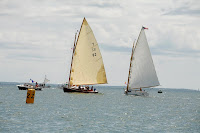Hi John -
I'm back at work today and just read your blog entry. I don't know how the MAID would have handled the big weather but I sure can't say that you made a bad decision by staying put. It was the biggest weather KATHLEEN has sailed in and next to a few squalls some of the biggest stuff I've been out in on Buzzards Bay.
We had two reefs and were going easily on broad reach around Monomoy - (oh and saw a big whale, humpback maybe just past the cut near the breaking waves) jibed around Monomoy and at dark the breeze picked up further calling for 4 reefs. Visibility was never an issue but it got windy and the wave height increased with the fetch. There was a lot of steering necessary to keep her headed down the waves and I was wondering how the MAID with her wheel would have handled the abrupt and constant rudder movements. It was an exhilarating ride and the boat felt like a planing dinghy as we averaged 8 knots past Hyannis. We decided to stop in Osterville, home to much of our crew for the night.
We lost 2 crew in Osterville but the 5 of us continued the next day at 10 with more downwind sailing in our future. Relatively easy going down Vineyard Sound as we were able to get into the lee of Falmouth but with 4 reefs we were still doing about 7 knots. The big decision was whether to continue down the sound and in the lee of the Elizabeth's with a more favorable current or go thru Woods Hole. We chose WH so that we could reach across BB while there wasn't a ton of fetch to gain as much windward gauge as we could before it got so that we could only run before it. It got gnarly enough to go to reef #5 when we were 1/2 way across the bay. Reef #5 is to drop the main completely and put up a 420 jib that we brought as a storm tri-sail. BB tower reports that it was blowing in the high 30's with some higher gusts. Under that rig everything was pretty mellow despite the occasional big roller coming over the stern and through the tiller hole. We were doing 4.5 knots with the current. The waves were really big off of Padanaram until we rounded Mishaum Pt. and then Gooseberry Neck and were more in the lee. TUBBY, the Boston Whaler Squall towed beautifully. We weren't sure that we'd be able to turn and go upwind up the Sakonnet as we'd have to put up the sail to do so. It was still windy and the waves were big again as we doused the jib and went up with the fully reefed main. It was slow going as the wind and waves drove us back but we slowly made progress up the river. As we continued north, the waves subsided and after an hour of slow progress we started moving along pretty well tacking back and forth. We put in just before dark off a friend's house south of the Tiverton bridge where she lays to 2 anchors now.
We had an experienced crew that had sailed the boat a lot, and one with extensive offshore experience. We made good decisions on when to shorten sail and were smart to get windward gauge when it was easy by cutting through Woods Hole. Cutting through Quicks Hole would have been a debachle as we'd have to put the sail up to head to the angle toward Sakonnet Pt. and the waves would have been more broadside.
I suspect you're stuck in Chatham for a day or two. Tony said the fishermen don't even attempt the cut on days like yesterday. Looks like good weather in a couple days though. Look out for that whale on the way out and see you in Bristol.
-Tim











